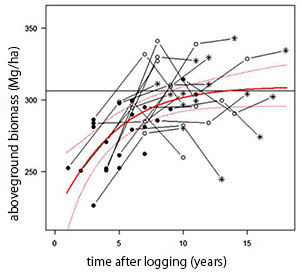Home > International Partnerships > Collaborative Research > Possibility of Using Reduced-Impact Logging (RIL) for the Sustainable Management of Amazonian Tropical Forest: Feasibility Study Based on the Growth Characteristics of Different Species
Update:March 2, 2020
Main content starts here.
Possibility of Using Reduced-Impact Logging (RIL) for the Sustainable Management of Amazonian Tropical Forest: Feasibility Study Based on the Growth Characteristics of Different Species

1. Partners
National Institute for Amazonian Research (INPA), Brazil
Japan International Research Center for Agricultural Sciences (JIRCAS), Japan
Kyoto University, Japan
Kochi University, Japan
2. Research Period
FY 2016-2018 Grant-in-Aid for Scientific Research (KAKENHI)
3. Lead Researcher
KAJIMOTO, Takuya
4. Background
Low-intensity selective logging, or reduced-impact logging (RIL), is considered an effective method for the sustainable management of tropical forests in the Amazon, where deforestation still continues primarily through illegal logging. However, while RIL may contribute to both ecosystem conservation and sustainable timber production, few feasibility studies have quantitatively evaluated the possibility of applying RIL in Amazonian tropical forests.
5. Research Goal
The objective of this study was to evaluate the possibility of applying RIL for the sustainable management of tropical forests in the central Amazon, Brazil, by considering the sustainability of both the forest carbon stock and timber production.
6. Research Strategy
We conducted a feasibility study in logging forests where RIL has been undertaken by a private company (Precious Woods Amazon Ltd., Itacoatiara, Brazil) since 1995. In this study, we examined the processes of post-logging forest recovery by estimating changes in aboveground biomass (AGB) at the stand level. To do this, we undertook repeated tree censuses in several logged forests with different logging histories. We also used the census data to evaluate species-specific annual growth rates at the individual level to examine the sustainability of wood production.
7. Scientific Achievement
We found that the AGB returned to the pre-logging level approximately 10–15 years after logging (Fig. 1), which fell within the planned logging cycle (i.e., 25 years), suggesting that the logging intensity (ca. <2–3 trees/ha) used by the company is sufficient for maintaining the forest carbon stock. The analysis of species-specific diameter growth rates further indicated that some of the major timber species retained a relatively high growth potential (2–3 mm per year), implying that sustainable wood production could be achieved in these species. However, more data on individual growth rates are required to support this.

Fig. Relationship between the time after logging (years) and the aboveground biomass (AGB) in forests in the central Amazon, Brazil, that have been exposed to reduced-impact logging (RIL). For each of the 20 research plots, the AGB values estimated at three different periods (●, ○, * ) are connected by straight line. Red curve indicates the estimated logistic growth of AGB (after Otani et al. 2018).
8. Applications
The findings of this study will help to improve the RIL method, which may contribute to the sustainable management of tropical forests in the Amazon, Brazil.
9. Publications
Suwa R、Silva F、Lima AJN、Pinto ACM、Santos J、Kajimoto T、Ishizuka M、Higuchi N (2016) Changes in forest structure and biomass over ten years in a lowland Amazonian forest. JARQ 50: 379-386.
Higuchi N、Suwa R、Higuchi FG、Lima AJN、Santos J、Noguchi H、Kajimoto T、Ishizuka M (2016) Overview of forest carbon stock study in Amazon State, Brazil. In: Nagy L et al. (eds). Interactions between biosphere, atmosphere, and human land use in the Amazon Basin. Ecological Studies 227、171-187、Springer.
Otani T、Lima AJN、Suwa R、Amaral MRM、Ohashi S、Pinto ACM、Santos JD、Kajimoto T、Higuchi N、Ishizuka M (2018) Recovery of above-ground tree biomass after moderate selective logging in a central Amazonian forest. iForest-Biogeosciences and Forestry 11(3)、352-359.
Copyright © Forest Research and Management Organization. All rights reserved.
